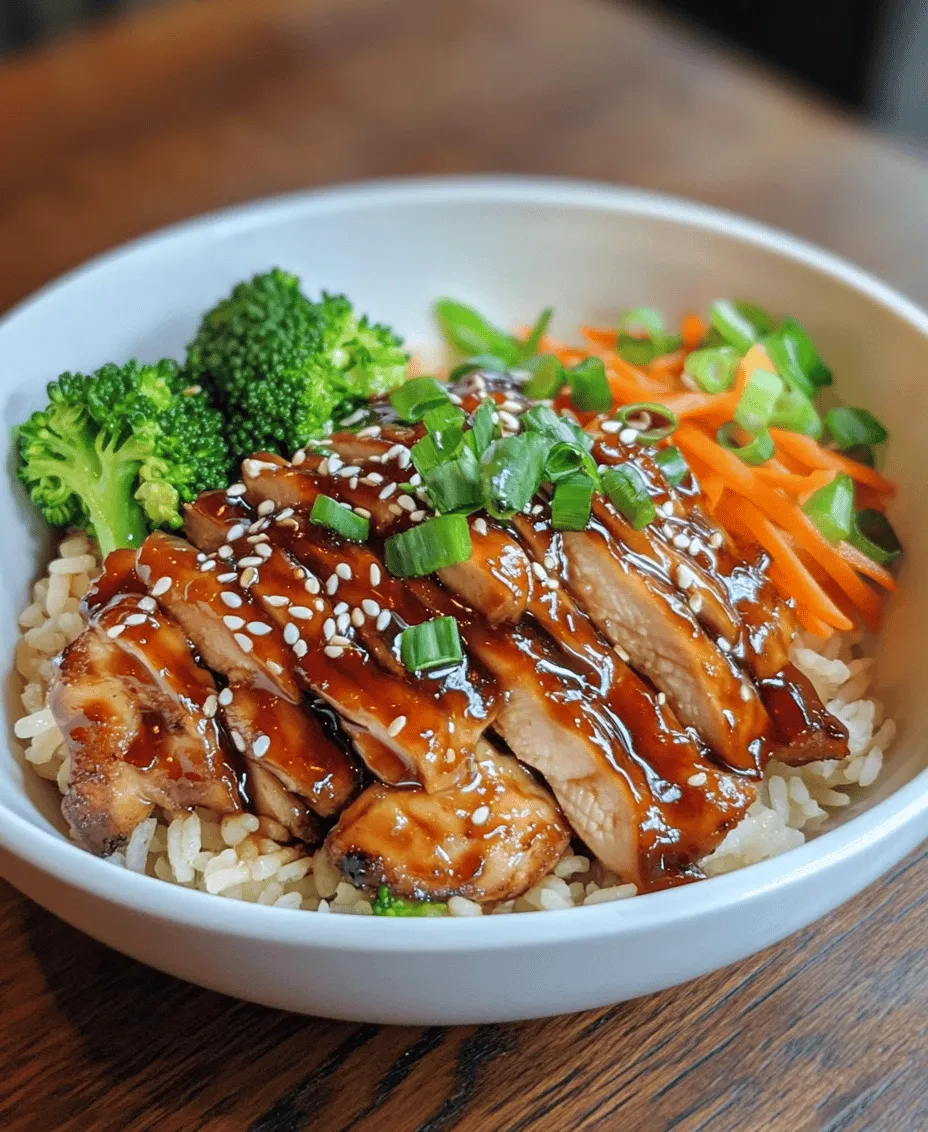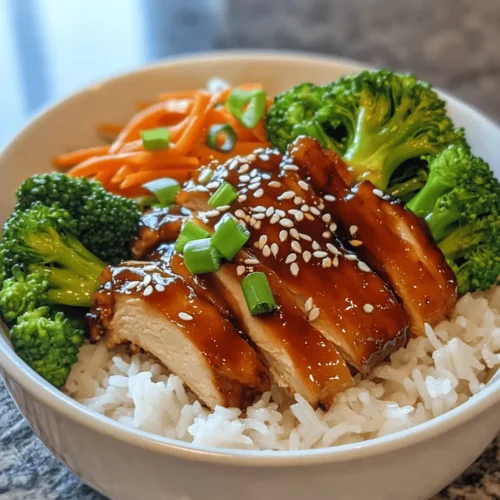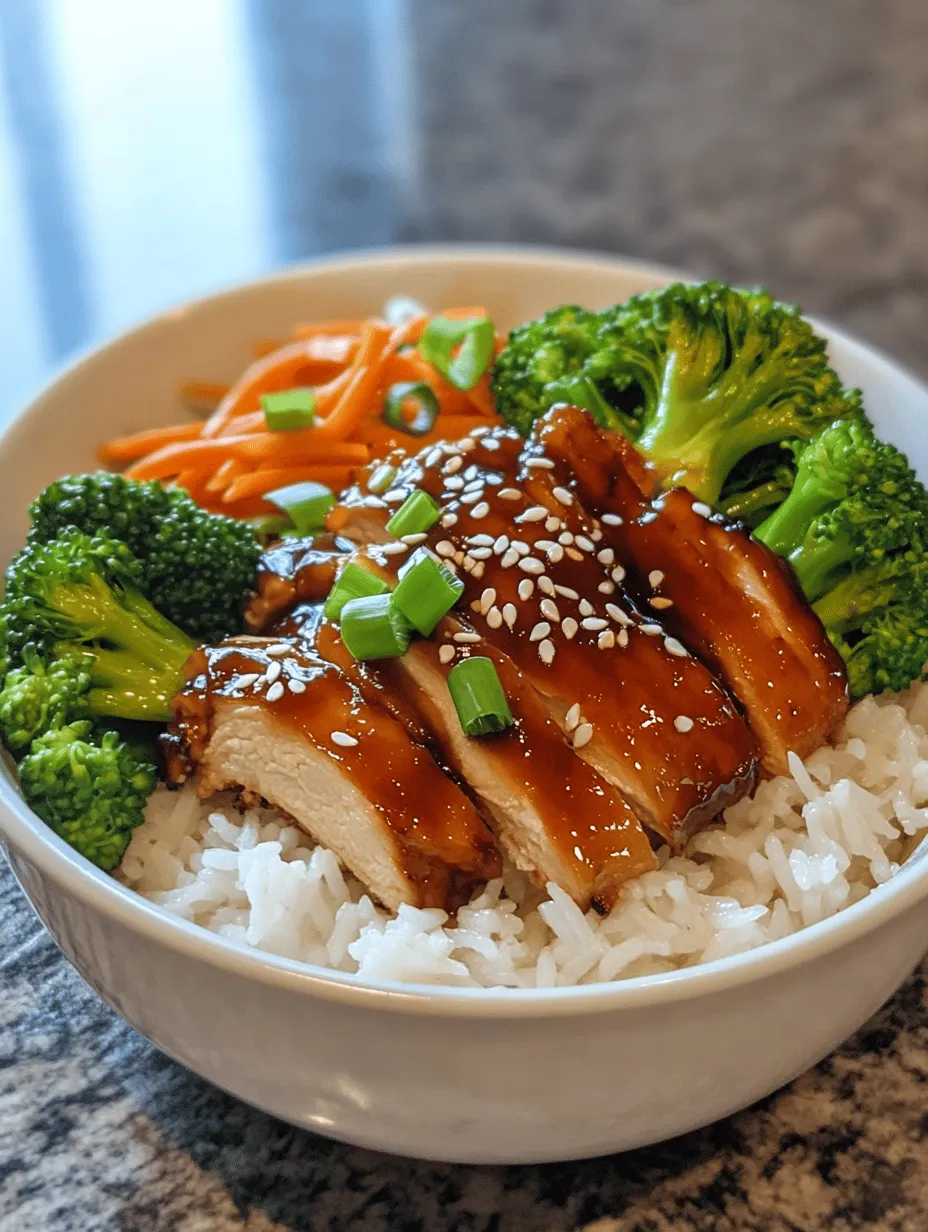In the realm of quick and satisfying meals, the Teriyaki Chicken Rice Bowl stands out as a vibrant and flavorful dish that caters to both health-conscious eaters and those seeking comfort food. This delightful bowl features succulent chicken thighs marinated in a homemade teriyaki sauce, served over fluffy jasmine rice and accompanied by a medley of fresh vegetables. It brings a taste of Japan right into your kitchen, making it an ideal choice for a weeknight dinner or a casual gathering with friends.
Whether you’re looking to impress guests or simply enjoy a nourishing meal, this dish is not only easy to prepare but also packed with nutrients. The combination of protein-rich chicken, wholesome vegetables, and hearty rice creates a balanced plate that satisfies hunger while delighting the palate. In this article, we will explore the ingredients, preparation steps, and cultural significance of this beloved dish, ensuring you have all the knowledge needed to create an authentic Teriyaki Chicken Rice Bowl.
Understanding the Ingredients
Exploring the Key Ingredients
Every great dish begins with quality ingredients, and the Teriyaki Chicken Rice Bowl is no exception. Let’s take a closer look at the components that come together to create this culinary delight.
Chicken Thighs
When it comes to making a flavorful Teriyaki Chicken Rice Bowl, chicken thighs are the preferred choice. This cut of meat is known for its juiciness and tenderness due to its higher fat content compared to chicken breasts. The richness of chicken thighs allows them to absorb the teriyaki marinade effectively, resulting in a deliciously moist and flavorful outcome.
Soy Sauce
Soy sauce is the backbone of the teriyaki flavor profile, providing the dish with the necessary saltiness and umami. A high-quality soy sauce can make a significant difference in the overall taste of the dish, so opt for a naturally brewed variety if possible. Its deep, savory flavor is what elevates the chicken to new heights.
Mirin
Mirin is a sweet rice wine that plays a crucial role in Japanese cuisine. It adds a layer of sweetness and complexity to the teriyaki sauce, balancing the saltiness of the soy sauce. Mirin also contributes to a glossy finish on the chicken, making it visually appealing when served.
Honey or Brown Sugar
To enhance the sweetness of the teriyaki sauce, either honey or brown sugar can be used. Both ingredients not only provide sweetness but also help caramelize the chicken during cooking, resulting in a beautifully glazed finish. The choice between the two can depend on personal preference, but each option adds a unique depth to the sauce.
Rice Vinegar
A splash of rice vinegar introduces a subtle acidity that enhances the overall flavor of the teriyaki sauce. It brightens the dish and helps balance the sweetness, ensuring that the sauce is well-rounded. Rice vinegar is a staple in many Asian cuisines and is essential for achieving an authentic taste.
Garlic and Ginger
The aromatic duo of garlic and ginger adds depth and warmth to the teriyaki sauce. Freshly minced garlic brings a pungent kick, while ginger contributes a zesty and slightly sweet flavor that complements the other ingredients beautifully. Together, they create a fragrant base that elevates the overall dish.
Optional Cornstarch
If you prefer a thicker teriyaki sauce, cornstarch can be added to achieve the desired consistency. By mixing cornstarch with a bit of water to create a slurry, you can thicken the sauce during the cooking process, ensuring it clings perfectly to the chicken and rice.
Sesame Oil
A drizzle of sesame oil at the end of the cooking process adds a finishing touch of warmth and richness to the dish. Its nutty flavor enhances the overall taste profile and provides a lovely aroma that makes the Teriyaki Chicken Rice Bowl even more inviting.
Jasmine Rice
Jasmine rice is the ideal base for this dish. Its slightly sweet and floral aroma pairs perfectly with the savory teriyaki chicken. The fluffy texture of cooked jasmine rice allows it to absorb the sauce well, making every bite a delightful experience. If jasmine rice isn’t available, consider using other long-grain rice varieties, but jasmine remains the top choice for authenticity.
Vegetables
For a well-rounded meal, incorporating vegetables is essential. Steamed broccoli and shredded carrots not only add vibrant colors to the dish but also offer a nutritious boost. Broccoli is rich in vitamins and minerals, while carrots provide a touch of sweetness and crunch. Feel free to customize the vegetable mix based on your preferences or seasonal availability.
Garnishes
To elevate the presentation and flavor of your Teriyaki Chicken Rice Bowl, consider adding garnishes such as sliced green onions and sesame seeds. Green onions provide a fresh, sharp contrast to the richness of the dish, while sesame seeds add a delightful crunch and nutty flavor. These finishing touches make the dish visually appealing and enhance the overall dining experience.
The Teriyaki Sauce Preparation
Creating the perfect teriyaki sauce is an essential step in crafting a delicious Teriyaki Chicken Rice Bowl. Follow this step-by-step guide to whisk together the ingredients for an authentic sauce that will elevate your dish.
1. Gather Your Ingredients: Start by measuring out the soy sauce, mirin, honey or brown sugar, rice vinegar, minced garlic, and grated ginger. Having everything pre-measured makes the process smoother and ensures you don’t miss any components.
2. Combine the Ingredients: In a medium-sized mixing bowl, combine the soy sauce, mirin, honey (or brown sugar), rice vinegar, minced garlic, and grated ginger. Use a whisk to blend the ingredients thoroughly, ensuring that the sweeteners dissolve completely.
3. Adjust the Flavors: Taste the sauce and adjust the flavors to your liking. If you prefer a sweeter sauce, add a bit more honey or brown sugar. For a saltier kick, you can increase the amount of soy sauce. This is your opportunity to customize the sauce based on your preferences.
4. Thicken the Sauce (Optional): If you desire a thicker sauce, mix a tablespoon of cornstarch with two tablespoons of water to create a slurry. Once the sauce ingredients are well combined, add the cornstarch mixture while continuously whisking. This will help thicken the sauce as it cooks.
5. Simmer the Sauce: In a saucepan over medium heat, pour the combined teriyaki sauce and bring it to a gentle simmer. Allow it to cook for about 5–7 minutes, stirring occasionally. This will help the flavors meld and create a more complex taste.
6. Finish with Sesame Oil: After the sauce has thickened to your liking, remove it from heat and add a drizzle of sesame oil for that final touch of flavor. Stir well to incorporate the oil, and your teriyaki sauce is now ready to be used for marinating the chicken.
The Importance of Marinating Chicken
The marination process is crucial in enhancing the flavor of the chicken thighs. By allowing the chicken to sit in the teriyaki sauce, it absorbs the rich flavors, resulting in a more delicious outcome. The ideal marination time is at least 30 minutes, but for the best results, aim for 1-2 hours. If you have the time, marinating overnight in the refrigerator will yield the most flavorful chicken.
Cooking the Chicken to Perfection
Once the chicken has marinated, it’s time to cook it to perfection. Here are some techniques to ensure your chicken thighs are juicy and full of flavor.
1. Preheat Your Pan: Begin by heating a large skillet or frying pan over medium-high heat. It’s essential to ensure the pan is hot before adding the chicken to achieve a nice sear.
2. Add Oil: Once the pan is hot, add a tablespoon of oil (such as vegetable or canola oil) to prevent sticking and help achieve a golden-brown crust.
3. Sear the Chicken: Remove the chicken thighs from the marinade, allowing any excess sauce to drip off. Carefully place them in the hot skillet, ensuring not to overcrowd the pan. Searing the chicken will create a beautiful caramelization on the outside.
4. Cook Through: Cook the chicken thighs for about 5-7 minutes on each side, or until the internal temperature reaches 165°F (75°C). For an extra crispy finish, consider searing each side for a minute longer.
5. Glaze with Teriyaki Sauce: In the last few minutes of cooking, return the reserved teriyaki sauce to the skillet, allowing it to coat the chicken. This will create a sticky glaze that enhances the flavor and adds a beautiful shine to the dish.
6. Rest the Chicken: Once cooked, remove the chicken from the skillet and let it rest for a few minutes before slicing. Resting allows the juices to redistribute, ensuring a moist and flavorful bite.
By following these steps, you will have perfectly cooked teriyaki chicken ready to be served atop a bed of jasmine rice and accompanied by vibrant vegetables. In the next sections, we will delve into assembling the Teriyaki Chicken Rice Bowl and offer tips for the best results, ensuring that you can enjoy a restaurant-quality dish in the comfort of your own home.

Importance of Using Leftover Marinade During Cooking
One of the secrets to amplifying the flavor of your Teriyaki Chicken Rice Bowl lies in the use of the leftover marinade. After marinating the chicken, you may be tempted to discard the remaining sauce, but resist that urge! The leftover marinade can be utilized during the cooking process to infuse the chicken with additional layers of flavor. As the chicken cooks, the marinade caramelizes and thickens, creating a rich glaze that beautifully coats each piece of meat. This not only enhances the taste but also adds a delightful sheen to your chicken, making it visually appealing.
To safely use the leftover marinade, make sure to bring it to a boil in a small saucepan for a few minutes to eliminate any bacteria. Once it has boiled, you can drizzle it over the chicken while it cooks, ensuring that the flavors deepen and develop. This step is crucial, as it transforms a simple dish into a flavor-packed experience.
How to Know When the Chicken is Fully Cooked
Cooking chicken to the right doneness is essential for both safety and taste. The best way to determine if your chicken is fully cooked is to use a meat thermometer. Insert the thermometer into the thickest part of the chicken; it should read at least 165°F (75°C) to ensure it is safe to eat. If you don’t have a thermometer on hand, you can also cut into the chicken to check. The meat should be opaque and the juices should run clear, not pink.
Preparing the Rice and Vegetables
Cooking Components Simultaneously
When creating your Teriyaki Chicken Rice Bowl, efficiency is key. Cooking the rice and vegetables simultaneously while the chicken is marinating allows you to save time and ensure that everything is ready to serve at the same time.
A Guide to Cooking Jasmine Rice: Tips for Perfect Texture
Jasmine rice is a popular choice for Teriyaki Chicken Rice Bowls due to its fragrant aroma and soft texture. Here’s how to cook jasmine rice perfectly:
1. Rinse the Rice: Start by rinsing your jasmine rice under cold water until the water runs clear. This removes excess starch and prevents the rice from becoming overly sticky.
2. Water Ratio: Use a water-to-rice ratio of 1.5 cups of water for every cup of rice. This ratio ensures the rice cooks evenly and absorbs just the right amount of moisture.
3. Cooking Method: For stovetop cooking, bring the water to a boil in a pot, add the rinsed rice, and a pinch of salt. Stir once, cover the pot with a lid, and reduce the heat to low. Cook for about 15 minutes without lifting the lid. Turn off the heat and let it sit for an additional 10 minutes to steam.
4. Fluff the Rice: After the resting period, fluff the rice with a fork to separate the grains and achieve the perfect light and airy texture.
Steaming Vegetables: Timing and Methods for Retaining Nutrients and Vibrant Colors
Steaming is an excellent method for cooking vegetables, as it helps retain both flavor and nutrients. Here’s how to steam your vegetables effectively:
1. Choose Your Vegetables: Common choices include broccoli, bell peppers, and snap peas. These vegetables provide color, crunch, and essential vitamins.
2. Prep the Vegetables: Cut them into uniform pieces to ensure even cooking. For instance, cut broccoli into bite-sized florets and slice bell peppers into strips.
3. Steaming Process: Fill a pot with about an inch of water and bring it to a boil. Place the vegetables in a steaming basket over the boiling water and cover. Steam for 3-5 minutes, depending on the type of vegetable. Aim for vibrant colors and tenderness without mushiness.
4. Seasoning: Once steamed, season the vegetables lightly with salt and a splash of soy sauce or sesame oil to enhance their natural flavors.
Assembling the Teriyaki Chicken Rice Bowl
Creating the Teriyaki Chicken Rice Bowl is where you can let your creativity shine. The assembly is crucial not only for aesthetics but also for flavor balance.
Step-by-Step Assembly of the Rice Bowl for Visual Appeal and Flavor Balance
1. Start with Rice: Begin by placing a generous scoop of fluffy jasmine rice in the center of a bowl. This serves as the base for your dish.
2. Layer the Chicken: Next, arrange slices of the teriyaki chicken over the rice. Be sure to drizzle some of the leftover marinade on top for extra flavor and moisture.
3. Add Vegetables: On one side of the bowl, artfully arrange the steamed vegetables. This not only adds color but also provides a contrast in texture to the tender chicken.
4. Garnish: Finish off with garnishes such as sliced green onions, sesame seeds, or even a sprinkle of nori flakes for added flavor and visual appeal.
Suggestions on Layering Ingredients for a Satisfying Bite
To ensure each bite is a delightful combination of flavors, consider the order in which you layer your ingredients. A great tip is to alternate between rice, chicken, and vegetables as you build your bowl. This way, you capture a bit of each component in every bite, creating a harmonious blend of textures and tastes.
Garnishing and Serving Suggestions
Finishing Touches for Presentation
Garnishes play a significant role in elevating the presentation of your Teriyaki Chicken Rice Bowl. They not only enhance visual appeal but also contribute additional flavors and aromas.
1. Fresh Herbs: Chopped cilantro or basil can add freshness and a pop of color.
2. Sesame Seeds: Toasted sesame seeds provide a nutty flavor and a pleasing crunch.
3. Nori Strips: Thin strips of nori can add a seaweed flavor that complements the teriyaki sauce perfectly.
4. Drizzle of Sauce: A light drizzle of teriyaki sauce over the top gives a glossy finish and invites diners to dig in.
Creative Ways to Serve and Present the Teriyaki Chicken Rice Bowl
Consider serving your Teriyaki Chicken Rice Bowl in unique ways to impress your family or guests:
– Bento Box Style: For a fun presentation, serve the rice, chicken, and vegetables in separate compartments of a bento box. This allows for visual appeal and encourages diners to mix their own bites.
– Layered Jars: For a grab-and-go option, layer the ingredients in a mason jar, starting with the rice, followed by the chicken, and topped with vegetables. This is perfect for meal prep and makes for an eye-catching presentation.
– Family Style: Serve all components separately on a large platter, allowing everyone to build their own bowls. This interactive approach can be a great conversation starter at dinner parties.
Nutritional Benefits of the Teriyaki Chicken Rice Bowl
Analyzing the Nutritional Content of the Ingredients
The Teriyaki Chicken Rice Bowl is not only delicious but also offers a range of nutritional benefits. Here’s a quick breakdown of what you’re getting with each ingredient:
– Chicken: A lean source of protein that supports muscle growth and repair while being low in fat.
– Jasmine Rice: Provides carbohydrates for energy and is a good source of B vitamins.
– Vegetables: Packed with vitamins, minerals, and fiber, they contribute to overall health and well-being, aiding in digestion and providing antioxidants.
Benefits of Incorporating Fresh Vegetables into Your Diet
Including a variety of fresh vegetables in your diet is essential for maintaining health. They contribute to:
– Vitamins and Minerals: Essential for bodily functions, including immune support and bone health.
– Fiber: Aids digestion and helps maintain a healthy weight.
– Hydration: Many vegetables have high water content, which contributes to overall hydration.
Understanding Portion Control and Balanced Meals
When assembling your Teriyaki Chicken Rice Bowl, it’s crucial to consider portion sizes. A balanced meal typically includes:
– Protein: Aim for a serving size of about 3-4 ounces of chicken.
– Grains: A half-cup of cooked jasmine rice is sufficient for energy.
– Vegetables: Fill half of your bowl with a variety of colorful vegetables to ensure you’re getting a range of nutrients.
Cultural Significance of Teriyaki Chicken
A Brief History of Teriyaki and Its Origins in Japanese Cooking
Teriyaki, which translates to “glazed or broiled,” has its roots in Japanese cuisine, where cooking methods often emphasize flavor enhancement through marinades. The technique of combining soy sauce, mirin, and sugar to create a sweet and savory glaze is integral to many traditional Japanese dishes. Teriyaki chicken, in particular, has become a staple not only in Japan but also across the globe, adapting to various culinary styles along the way.
The Cultural Importance of Rice Bowls in Japanese Meals
Rice bowls, or “donburi,” hold a significant place in Japanese cuisine. They represent comfort and simplicity, often featuring a protein, vegetables, and rice all in one dish. This style of meal allows for a balanced diet while showcasing the depth of flavors found in Japanese cooking.
How Teriyaki Has Evolved and Its Popularity Worldwide
Through globalization, teriyaki has transcended its traditional roots, becoming a beloved dish in many countries. Variations abound, from teriyaki burgers to teriyaki tacos, showcasing the versatility of this flavor profile while maintaining its core essence. The rice bowl format has also gained popularity, appealing to those seeking a quick, nutritious meal that doesn’t compromise on taste.
Conclusion: Enjoying Your Teriyaki Chicken Rice Bowl
In summary, the Teriyaki Chicken Rice Bowl is more than just a meal; it’s an experience that celebrates the flavors of Japan while providing a nutritious option for any table. By understanding the ingredients, preparation techniques, and cultural context, you can recreate this delightful dish with confidence.
Whether enjoyed on a busy weeknight or served during a gathering, this rice bowl is sure to please a variety of palates with its harmonious blend of flavors and textures. As you savor each bite, appreciate the journey of cooking and the joy of sharing a meal that embodies both tradition and innovation.



